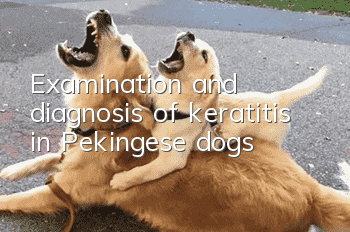Examination and diagnosis of keratitis in Pekingese dogs

I remember that the first dog I came into contact with when I was a child was the poodle, besides the native dogs in the countryside. It had a personality, strong expressiveness, and its image resembled a lion. Later, when I came into contact with more dogs, I realized that this breed is Pekingese, also known as Pekingese. Dog, palace poodle, is an ancient dog breed in China. The Pekingese dog originated in China and continued from the time of Qin Shihuang to the Qing Dynasty. The Pekingese dog has always been used as a reward dog in the palace and has been favored in all dynasties. It is a kind of A well-balanced, compact dog, heavy in the forequarters and light in the hindquarters. It represents courage, boldness, and self-esteem more than beauty, elegance, or sophistication.
1. Case introduction
I went to see a doctor on April 20, 2014. The main complaint was that the disease lasted for one month. I had been diagnosed and treated in other animal hospitals, but the medication was ineffective. The cornea of the right eye was turbid (see Figure 1), there were convex objects on the cornea (see Figure 2), the cornea was swollen, and the eyeball was red and swollen with tears. The sick dog was in good spirits.
2. Diagnosis
After examination, it was confirmed that the right eye had traumatic corneal opacity and corneal edema.
When opaque white scars form on the cornea surface, it is called corneal opacification. Corneal opacity is the result of corneal edema and cellular infiltration, causing the surface or deep layers of the cornea to become dark and opaque. Corneal turbidity is generally milky white or orange-yellow. Mild corneal opacity appears blurry or aerosol-like. In severe cases, the corneal stroma has a dense blue appearance, colloquially known as "ground glass" or "blue eye." The new corneal opacity has symptoms of inflammation, the boundary is not obvious, and the surface is rough and slightly raised. Old corneal turbidity has no symptoms of inflammation and is clearly bordered. When there is deep turbidity, a thin transparent layer can be seen on the surface of the turbidity during side inspection; in shallow turbidity, no thin transparent layer can be seen, and it is mostly blue cloud-like.
Corneal edema is classified as diffuse or focal. Focal edema does not affect vision, but diffuse edema can cause some visual impairment. Determine the nature of the eye by gently pressing it with your fingers. If it is focal edema, it will expand when you press it; if it is diffuse edema, the density of the edema will increase when you press it.
- What to do if your dog has double rows of teeth
- Things to note when feeding Teddy dogs
- Signs your dog loves you
- Common dog diseases in winter
- What are the symptoms of rabies in dogs?
- What are the symptoms of false pregnancy in dogs?
- Letting your dog walk upright is very harmful. Don’t let your ignorant interest ruin your dog’s life!
- What should I do if my dog has fleas? How to get rid of fleas on your dog?
- Why should a dog’s tail be docked? What are the reasons for docking a dog’s tail?
- What causes tear stains in dogs and how to improve them



